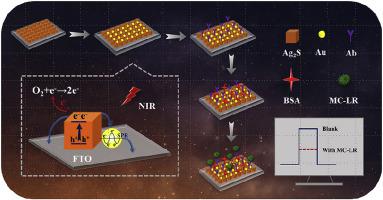Talanta ( IF 6.1 ) Pub Date : 2020-07-31 , DOI: 10.1016/j.talanta.2020.121447 Chenyan Zheng 1 , Mingming Yin 1 , Bingyuan Su 2 , Aihong Peng 1 , Zhiyong Guo 3 , Xiaomei Chen 1 , Xi Chen 4

|
As a main contaminant in fish, microcystin-LR (MC-LR) leads to serious liver problems; therefore, the development of MC-LR sensors is important to guarantee aquatic food safety. In this work, a near-infrared (NIR) light-excited photoelectrochemical (PEC) immunosensor was developed through conjugation of Ag2S cubes with Au nanoparticles (NPs) to determine MC-LR residues in fish. Specifically, as a narrow-band semiconducting material, Ag2S is capable of absorbing NIR light. Taking advantage of the localized surface plasmon resonance (LSPR) effect along with good conductivity of AuNPs, the developed AuNP/Ag2S/fluorine-doped tin oxide (FTO) owns much higher photoelectric conversion efficiency, and the photocurrent is 5.3 times that of Ag2S FTO. Subsequently, the NIR-driven AuNP/Ag2S/FTO was used to immobilize antibodies (Abs) for MC-LR. Their specificity to MC-LR led to steric effects and limited surface electron transfer, causing reduce of the photocurrent. Through AuNP/Ag2S-composite amplification and immunological specificity, the PEC immunosensor can quantitatively measure MC-LR with a wide linear range, 10 pg L−1 to 10 μg L−1, and a much low detection limit, 7 pg L−1 (S/N = 3). Finally, the NIR PEC sensor was employed in the analysis of MC-LR contents in fish. This work reveals the NIR-responsive ability of Ag2S cubes and deepens understanding the role of AuNPs in the PEC process. Due to the superior properties, the developed NIR PEC immunosensor has been demonstrated as a promising method for analysis of biological samples.
中文翻译:

基于 Ag2S 立方体和等离子 Au 纳米粒子的新型近红外光响应光电化学平台用于检测鱼类中的微囊藻毒素-LR
作为鱼类的主要污染物,微囊藻毒素-LR (MC-LR) 会导致严重的肝脏问题;因此,开发MC-LR传感器对于保障水产食品安全具有重要意义。在这项工作中,通过将 Ag 2 S 立方体与 Au 纳米粒子 (NPs)结合,开发了一种近红外 (NIR) 光激发光电化学 (PEC) 免疫传感器,以测定鱼类中的 MC-LR 残留物。具体而言,作为窄带半导体材料,Ag 2 S能够吸收近红外光。利用局域表面等离子共振(LSPR)效应和AuNPs良好的导电性,所开发的AuNP/Ag 2 S/氟掺杂氧化锡(FTO)具有更高的光电转换效率,光电流是金纳米粒子的5.3倍。银2S FTO。随后,NIR 驱动的 AuNP/Ag 2 S/FTO 用于固定 MC-LR 的抗体 (Abs)。它们对 MC-LR 的特异性导致空间效应和有限的表面电子转移,导致光电流降低。通过AuNP/Ag 2 S-复合扩增和免疫特异性,PEC免疫传感器可以定量测量MC-LR,线性范围宽,10 pg L -1至10 μg L -1,检测限低得多,7 pg L -1(信噪比 = 3)。最后,将 NIR PEC 传感器用于鱼中 MC-LR 含量的分析。这项工作揭示了 Ag 2的 NIR 响应能力S 立方体并加深了对 AuNP 在 PEC 过程中的作用的理解。由于优越的性能,开发的 NIR PEC 免疫传感器已被证明是一种有前途的生物样品分析方法。


























 京公网安备 11010802027423号
京公网安备 11010802027423号